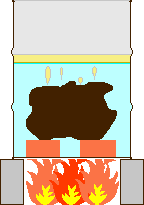Candle Making Index
Comb and Foundation
Showing Beeswax
|
|
|
|---|
Wax Melting
Beeswax is easily melted (too easily sometimes) but we must take care that we do not damage the chemical and physical structure of it by over heating.
|
Candle Making Index Comb and Foundation Showing Beeswax |
Wax MeltingBeeswax is easily melted (too easily sometimes) but we must take care that we do not damage the chemical and physical structure of it by over heating. |
|---|
|
|---|
The objective of this page is to produce wax blocks that may still retain some contaminants or dross, that can be further processed along the lines illustrated in the Filtering Beeswax page. A two stage process is helpful, as the first can be a "wet" phase, with the second or subsequent meltings being done without water. Any water that comes into contact with molten or melting beeswax should be acidified to avoid saponification.
Comb for melting can be graded for colour. Cappings wax is usually fairly light and so is freshly drawn comb. Comb that is incompletely drawn may be virtually white and not yet had any propolis applied to it that might stain it. This should be saved for show purposes. Old brood combs may produce an orange or brown wax and this can still be utilised, but should be segregated from those combs that will produce a light wax.
Wax selection and colour grading can matter if foundation is you chosen product. Dark wax doesn't affect the bees, but it is beekeepers that buy wax not the bees, and beekeepers are conditioned to prefer light colours.
Steam Extraction... I live in a small town in Leicestershire called Syston, If Syston has any claim to fame it is for the design and development of the steam wax extractor and so it has a page devoted to it.
Kitchen Stove Method... For small quantities, I start with a large saucepan about a quarter full of water that has been acidified with lemon juice, lime juice or vinegar (one or two teaspoons per pint of water).
I heat this directly on an electric ring, but at a very low power and add my dirty wax and fragments of comb in chunks as small as practical (grape to walnut size) until the pot is three quarters full. This melting pot needs watching and stirring continuously and will take some time to bring to a very minor boil.
This boiling action must be very, very, gentle so that there are millions of fine bubbles. It is these small bubbles that allow water to contact the contamination that is distributed throughout the molten wax.
Do not boil for more than five minutes, or too vigorously, otherwise damage can occur that will turn the wax chocolate brown. Such damaged wax still has it's uses in making candles, but should be kept completely separate from naturally coloured wax.
The pot should be left to cool naturally for 24 to 48 hours, after which time you will have a circular cake of wax that has shrunk enough to remove easily. The wax itself will still contain debris, but the water soluble items will be in the water and in the scummy layer under the cake. Scrape off the loose muck (it makes good compost). This brownish stuff is a jumbled up mixture of fragments of cocoons, particles of chitin (Kaitin), pollen husks, propolis, dust particles, wax moth eggs, wax moth faeces, wax moth silk, pollen grains as well as solid and soluble bee faeces.
I follow up this part of the process by putting the resulting cakes in my Solar wax extractor or sometimes when there is not enough sun to make this work adequately, I use my warming cabinet for the next stage of filtration. These waterless techniques also allow any entrapped water to evaporate and escape.
|
Burlap Bag Method... This can be done on a fairly large scale using sacks made from burlap cloth. An empty oil drum with one end cut off can be used as a vessel to heat water over a bonfire which provides the heat for melting. The method is fairly simple... The sack is filled with the old comb, dirty wax and a few bricks or stones and then the end is tied closed. The weighted bag will not float and is immersed in the water in the oil drum that is supported on concrete blocks and the whole lot is heated by building a fire under the end of the drum. The bag is raised from the metal surface by a few bricks so that the water temperature does the melting and not the heated steel base of the drum. The wax melts and being less dense than the water, it will percolate through the coarse cloth and rise to the surface. The majority of the impurities will be entrapped inside the bag. |

|
|---|
Wax for showing needs special selection and treatment. The linked page gives details of the rather tedious methods that will need to be followed in order to achieve standards high enough to satisfy the judges at honey shows.
Dave Cushman.
Page created September 2000
Page updated 29/12/2022
Written... September 2000, Revised... 09 February 2002, Additions... 09, 10 November 2002, Upgraded... 01 May 2005, Code Corrected... 30 September 2006,
|